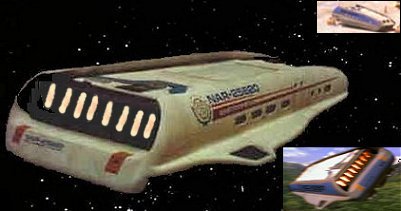
Starfleet Auxiliaries:
Definition: 'Ships that assist Starfleet starships in their duties'.
Academy myths about Starfleet auxiliaries include that they are ships for less-able Starfleet graduates, mostly freighters and totally boring to be on; unchallenging and tedious missions following starships around.
The reality is that Auxiliary assignments can be one of the most challenging and often exciting and up-front assignments that a Starfleet graduate can do. Viewed as a non-military vessel, a Starfleet Auxiliary vessel can sometimes find itself in places that regular Starfleet vessels are prohibited from; Klingon Station los pagh los was one such destination.
 Starfleet Auxiliaries operate differently as compared to Starfleet starships. Auxiliaries spend more time away on average per year from starbases and planetary facilities than Starfleet vessels do. Auxiliaries are operated by Starfleet Corps of Engineering personnel, these have NAR registry numbers, such as NAR 6135, S.S. Argus. Others are operated by non-Starfleet Federation personnel under NFT registry numbers. (As per RFA Diligence: She typically has deployments of 5-8 years in support of the Trafalgar-class submarine on duty east of Suez, with a secondary role as a mother ship for British and US minesweepers in the Persian Gulf).
Starfleet Auxiliaries operate differently as compared to Starfleet starships. Auxiliaries spend more time away on average per year from starbases and planetary facilities than Starfleet vessels do. Auxiliaries are operated by Starfleet Corps of Engineering personnel, these have NAR registry numbers, such as NAR 6135, S.S. Argus. Others are operated by non-Starfleet Federation personnel under NFT registry numbers. (As per RFA Diligence: She typically has deployments of 5-8 years in support of the Trafalgar-class submarine on duty east of Suez, with a secondary role as a mother ship for British and US minesweepers in the Persian Gulf).
Auxiliaries perform a number of roles: Logistics, tankers, hospital ships, repair vessels and many more besides. Auxiliaries are expected to perform their duties no matter the conditions and often without the resources and capabilities of a starship. Auxiliaries are often expected to put themselves in harm's way, despite the fact that auxiliaries have poor defences, are not very manoeuvrable and not designed for combat in the way that starships are.
For the tanker role, Starfleet has the Deneva class, which is the latest in the evolution of container tugs. The Starfleet replenishment vessel of choice for forward-deployed missions is the Mughi class. For the transportation of personnel, the Sydney class and Ptolemy class derivatives are the principal vessels. Starfleet Auxiliaries also cover medical vessels such as Solace and Hippocrates class.
Auxiliaries require above-average personnel who must be resourceful and quick-thinking and able to solve problems without the technological 'magic' that Starfleet starships have to offer. Auxiliaries require officers from all fields, though perhaps for not all of the time. Thus a Starfleet officer may be assigned for months rather than years. Ships may become associated with a specific role or assignment. For example, S.S. Argus, NAR 6135, was assigned to the Klingon Utility Station los pagh los to assist in repairing the atmospheric damage caused by the explosion of the moon Praxis. Humanitarian missions are often run with Starfleet Auxiliary and Hospital Ships.
Starfleet Auxiliary vessels tend not to have the scientific and laboratory facilities of standard Starfleet ships. Equally they tend to have only category three defensive armament. For dangerous environments, it may be necessary to have Federation Starfleet Marine Corps personnel onboard as a protection unit. Auxiliaries tend to have designated forward areas of operation to support the Starfleet ships in that region. Occasionally they can be asked to operate alone, as in the previously mentioned Praxis clean-up operation.
The concept for smaller, faster auxiliaries comes from a conversation with Rick Sternbach on 19/2/13:
Rick wrote: "I don't believe I'd put too many lumbering giant tankers out there, especially near conflict areas. Wouldn't want those things to get hijacked. :) Smaller ships with 2-3 cruiser-loads of De and/or antimatter, some defensive weaps, and a fast propulsion system. And not much else."









 Starfleet Auxiliaries operate differently as compared to Starfleet starships. Auxiliaries spend more time away on average per year from starbases and planetary facilities than Starfleet vessels do. Auxiliaries are operated by Starfleet Corps of Engineering personnel, these have NAR registry numbers, such as NAR 6135, S.S. Argus. Others are operated by non-Starfleet Federation personnel under NFT registry numbers. (As per RFA Diligence: She typically has deployments of 5-8 years in support of the Trafalgar-class submarine on duty east of Suez, with a secondary role as a mother ship for British and US minesweepers in the Persian Gulf).
Starfleet Auxiliaries operate differently as compared to Starfleet starships. Auxiliaries spend more time away on average per year from starbases and planetary facilities than Starfleet vessels do. Auxiliaries are operated by Starfleet Corps of Engineering personnel, these have NAR registry numbers, such as NAR 6135, S.S. Argus. Others are operated by non-Starfleet Federation personnel under NFT registry numbers. (As per RFA Diligence: She typically has deployments of 5-8 years in support of the Trafalgar-class submarine on duty east of Suez, with a secondary role as a mother ship for British and US minesweepers in the Persian Gulf).





